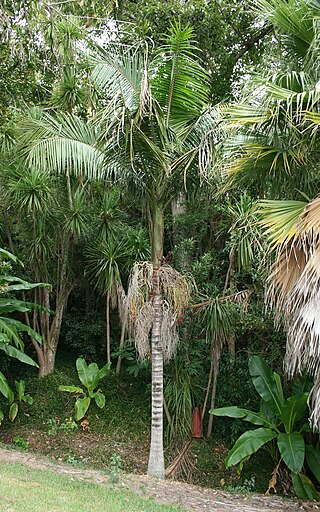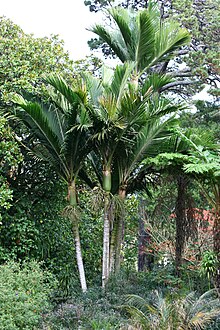
Hedyscepe canterburyana, the big mountain palm or umbrella palm, is the sole species in the genus Hedyscepe of the family Arecaceae. It is endemic to Lord Howe Island, Australia and is threatened by habitat loss. It is a solitary palm with a distinct crownshaft, and bears unisexual flowers of both sexes. With the Rhopalostylis palms of Norfolk Island and New Zealand it forms the botanic subtribe Rhopalostylidinae. If differs from Rhopalostylis in minor floral details including having more than six stamens, and in being protandrous rather than protogynous. The two genera were formerly included in Archontophoenicinae until a recent revision. In some molecular phylogenetic analyses, Hedyscepe was found to be nested in the New Caledonia endemic Basselinia.

The Ceroxyloideae are a subfamily of flowering plants in the palm family found mainly in the Americas with an outlying genus in each of Australia, Madagascar, and the Comoros. Recently revised, the former subfamily Phytelephantoideae was reduced to the tribal level and included, while the Hyophorbeae tribe was reassigned to Arecoideae; it now contains eight genera.

Archontophoenicinae is a botanical subtribe consisting of four genera of palms, namely Archontophoenix from Queensland and New South Wales and Actinokentia, Chambeyronia and Kentiopsis from New Caledonia. Phylogenetic relationships between the four genera are unresolved.

The Coryphoideae is one of five subfamilies in the palm family, Arecaceae. It contains all of the genera with palmate leaves, excepting Mauritia, Mauritiella and Lepidocaryum, all of subfamily Calamoideae, tribe Lepidocaryeae, subtribe Mauritiinae. However, all Coryphoid palm leaves have induplicate (V-shaped) leaf folds, while Calamoid palms have reduplicate leaf folds. Pinnate leaves do occur in Coryphoideae, in Phoenix, Arenga, Wallichia and bipinnate in Caryota.

Corypheae is a tribe of palm trees in the subfamily Coryphoideae. In previous classifications, tribe Corypheae included four subtribes: Coryphinae, Livistoninae, Thrinacinae and Sabalinae, but recent phylogenetic studies have led to the genera within these subtribes being transferred into other tribes. Tribe Corypheae is now restricted to the genus Corypha alone.

Cryosophileae is a tribe of palms in the subfamily Coryphoideae. The tribe ranges from southern South America, through Central America, into Mexico and the Caribbean. It includes New World genera formerly included in the tribe Thrinacinae, which was split after molecular phylogenetic studies showed that Old World and New World members of the tribe were not closely related.
Areceae is a palm tree tribe in the family Arecaceae.

Dypsidinae is a subtribe of plants in the family Arecaceae.

Caryoteae is a tribe in the palm family Arecaceae, distributed across Southeast Asia, from southern India and Sri Lanka east to Vanuatu and northernmost Queensland, Australia. It was long considered a member of subfamily Arecoideae on the basis of its inflorescences, which resemble those of tribe Iriarteeae, and the flowers arranged in triads, which are common across Arecoideae. However, phylogenetic studies based on DNA repeatedly link Caryoteae to subfamily Coryphoideae. Caryoteae do have leaves with induplicate folds, a feature found in most Coryphoid palms, but unlike most Coryphoideae, the leaves are pinnate or bipinnate (Caryota). Phoenix is the only other Coryphoid genus with induplicate, pinnate leaves.

Borasseae is a tribe in the palm subfamily Coryphoideae. The tribe ranges from southern Africa and Madagascar north through the Arabian Peninsula to India, Indochina, Indonesia and New Guinea. Several genera are restricted to islands in the Indian Ocean. The two largest genera, Hyphaene and Borassus, are also the most widespread.

Chuniophoeniceae is a tribe of palms in subfamily Coryphoideae of plant family Arecaceae. The four genera within the tribe are morphologically dissimilar and do not have overlapping distributions. Three of the genera are monotypic, while the fourth genus (Chuniophoenix) has three species.

Trachycarpeae is a tribe of palms in subfamily Coryphoideae of the plant family Arecaceae. It has the widest distribution of any tribe in Coryphoideae and is found on all continents, though the greatest concentration of species is in Southeast Asia. Trachycarpeae includes palms from both tropical and subtropical zones; the northernmost naturally-occurring palm is a member of this tribe. Several genera can be found in cultivation in temperate areas, for example species of Trachycarpus, Chamaerops, Rhapidophyllum and Washingtonia.
Lepidocaryeae is a tribe of plants in the family Arecaceae. Subtribes and genera in the tribe are:

Geonomateae is a palm tribe in the subfamily Arecoideae. It is an important Neotropical group due to its wide distribution across Central and South America, its diversity and abundance, and the use of a number of species by local human populations. The distribution of the tribe stretches from southeast Mexico down through Central America and into South America, notably Brazil and Bolivia, and species are also found in the Greater and Lesser Antilles. This tribe consists of a group of understory and sub-canopy palms that populate both tropical lowland and montane forests. While members of this group are relatively easy to collect, as they are not canopy palms or spiny palms, and are well represented in herbaria, the taxonomy and phylogeny of the species within the tribe are still uncertain. The resolution of the tribe has been disputed despite the fact that tribe's species are characterized by three morphological synapomorphies: the petals of pistillate flowers are basally connate, the presence of slender and elongate styles, and the flowers are borne in pits in the rachillae.
Ancistrophyllinae is a subtribe of plants in the family Arecaceae found in Africa. Genera in the subtribe are:
Mauritiinae is a subtribe of plants in the family Arecaceae found in northern South America. Genera in the subtribe are:
Plectocomiinae is a subtribe of plants in the family Arecaceae found in Southeast Asia. Genera in the subtribe are:

Rhapidinae is a subtribe of plants in the family Arecaceae found in Southeast Asia and the Mediterranean. Genera in the subtribe are:
Lataniieae is a subtribe of plants in the family Arecaceae. Genera in the subtribe are:

Genera Palmarum is a botany reference book that gives a detailed overview of the systematic biology of the palm family (Arecaceae). The first edition of Genera Palmarum was published in 1987. The second edition was published in 2008, with a reprint published in 2014. Genera Palmarum is currently the most detailed monograph on palm taxonomy and systematics.
















